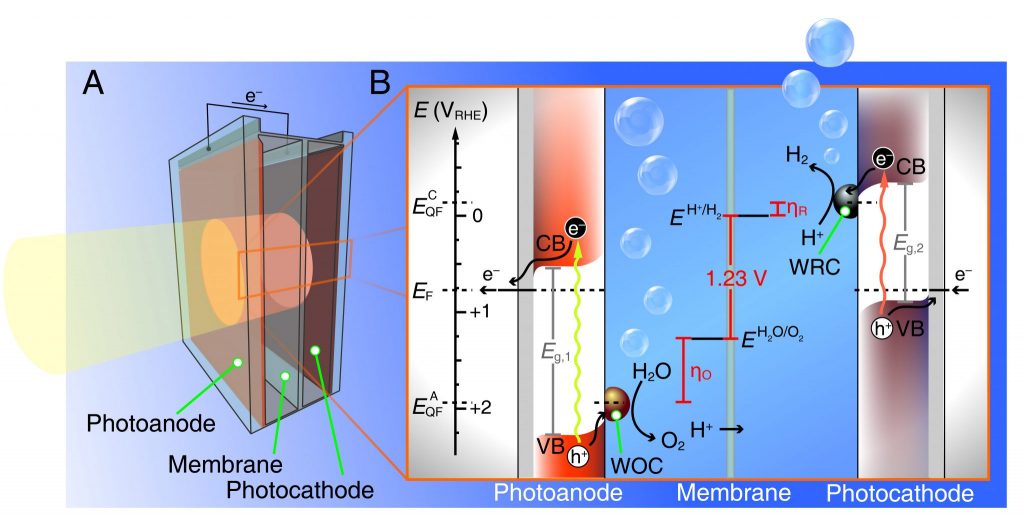via Photoelectrochemical devices
To enable a sustainable society based primarily on solar energy, methods to store sunlight as chemical fuels are needed. Photoelectrochemical (PEC) devices offer the promise of solar fuel production through artificial photosynthesis. While the idea of carbon-neutral energy economy powered by the “artificial leaf” is intriguing, viable PEC energy conversion on a global scale requires the development of a device with simplicity, stability, and high efficiency. LIMNO works to advance the field of PEC solar fuel production by developing specific classes of promising semiconducting materials (e.g. transition metal dichalcogenides, organic semiconductors, and metal oxide semiconductors). In addition, LIMNO’s research focuses on understanding and improving the operation of overall PEC devices via interface engineering and advanced photoelectrochemical strategies/techniques. See specific examples of our research reports below.

Representative publications:
Please note that the publication lists from Infoscience integrated into the EPFL website, lab or people pages are frozen following the launch of the new version of platform. The owners of these pages are invited to recreate their publication list from Infoscience. For any assistance, please consult the Infoscience help or contact support.
Alternative Oxidation Reactions for Solar-Driven Fuel Production
ACS Catalysis. 2019. Vol. 9, p. 2007-2017. DOI : 10.1021/acscatal.8b04565.Please note that the publication lists from Infoscience integrated into the EPFL website, lab or people pages are frozen following the launch of the new version of platform. The owners of these pages are invited to recreate their publication list from Infoscience. For any assistance, please consult the Infoscience help or contact support.
Potential-sensing electrochemical atomic force microscopy for in operando analysis of water-splitting catalysts and interfaces
Nature Energy. 2018. Vol. 3, p. 46-52. DOI : 10.1038/s41560-017-0048-1.Please note that the publication lists from Infoscience integrated into the EPFL website, lab or people pages are frozen following the launch of the new version of platform. The owners of these pages are invited to recreate their publication list from Infoscience. For any assistance, please consult the Infoscience help or contact support.
Semiconducting materials for photoelectrochemical energy conversion
Nature Reviews Materials. 2016. Vol. 1, num. 2, p. 15010. DOI : 10.1038/natrevmats.2015.10.Please note that the publication lists from Infoscience integrated into the EPFL website, lab or people pages are frozen following the launch of the new version of platform. The owners of these pages are invited to recreate their publication list from Infoscience. For any assistance, please consult the Infoscience help or contact support.
Surface modification of semiconductor photoelectrodes
Physical Chemistry Chemical Physics. 2015. Vol. 17, num. 24, p. 15655-15674. DOI : 10.1039/c5cp01992c.Please note that the publication lists from Infoscience integrated into the EPFL website, lab or people pages are frozen following the launch of the new version of platform. The owners of these pages are invited to recreate their publication list from Infoscience. For any assistance, please consult the Infoscience help or contact support.
A Bismuth Vanadate-Cuprous Oxide Tandem Cell for Overall Solar Water Splitting
Journal Of Physical Chemistry C. 2014. Vol. 118, num. 30, p. 16959-16966. DOI : 10.1021/jp500441h.Please note that the publication lists from Infoscience integrated into the EPFL website, lab or people pages are frozen following the launch of the new version of platform. The owners of these pages are invited to recreate their publication list from Infoscience. For any assistance, please consult the Infoscience help or contact support.